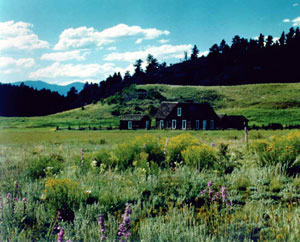Hornbek Homestead National Monument
Client: National Park Service
Site: Florissant Fossil Beds, Colorado

The Homestead Act of 1862 was passed to ease overcrowding in the East and help small and would-be farmers by providing inexpensive land. The law stated that a U.S. citizen (or a person intending to become one) who was the head of a family and over 21 years of age could qualify for a land grant of 160 acres (one quarter square mile). To receive the land, applicants had to pay a $10.00 registration fee, live on the site for at least 6 months of every year for five years, and cultivate and improve the land for five full years. Settlers could purchase the land outright after only six months of residence at a cost of $1.25 per acre. By 1900, nearly 400,000 individuals or families had filed for land under the provisions of the Act. Before the passage of the Homestead Act, it was nearly impossible for middle or lower class women to acquire land. They had few opportunities for employment and consequently little ability to accumulate the money necessary for buying land. Under the Homestead Act, however, unmarried, widowed or divorced women could claim homestead land as head of a household. By making land affordable the Homestead Act gave some women, like Adeline Hornbek, the chance to gain financial independence. A single mother of four, Adeline Hornbek defied traditional gender roles to become the owner of a prosperous ranch in Colorado's Florissant Valley. The Hornbek Homestead is a living illustration of the homesteading history of this area, and includes a variety of buildings of 19th-century log construction. The interpretive use of the Hornbek Homestead was well established as part of the National Monument, which has 40,000 to 60,000 annual visitors. A Preservation Plan was required to address issues involved with the deterioration of the homestead structures. The Collaborative completed field evaluations, defined treatments to stabilize log and structural deterioration, and prepared long-term and cyclical maintenance plans. Two particular concerns addressed by the firm’s Preservation Plan were the high water table and the fact that the National Park Service wished to utilize its own workforce as much as possible.
